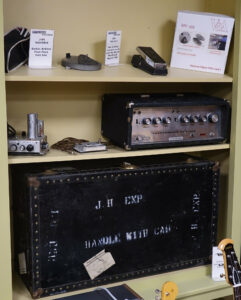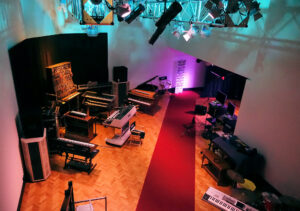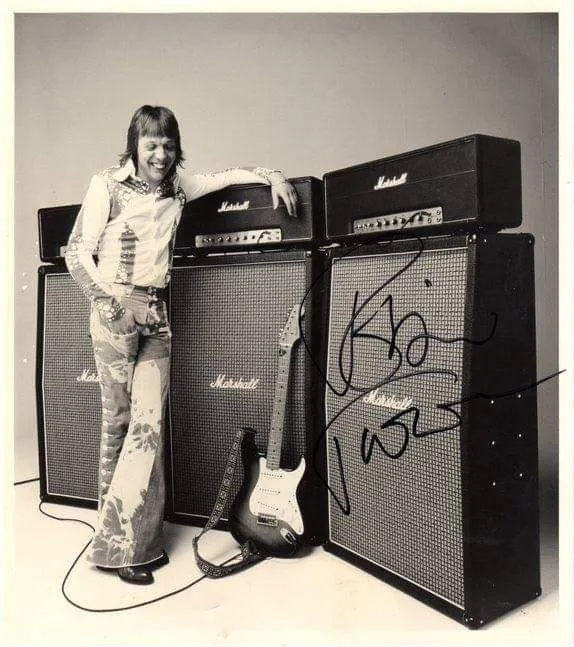Guardians of Musical History, Inspiration for Tomorrow…
- Home
- From the Author
- Uncategorized
- Guardians of Musical History, Inspiration for Tomorrow…

With apologies for a blogless summer, here’s a return to action. After a year of pandemic inactivity, full vaccination allowed me to visit some interesting places. Here’s one stop from the very top of the list…
It’s one of the most recognizable visual shapes in the wide, wide realm of guitar effects pedals: the humble wah-wah pedal. But this innocent appearing Vox wah is a secret weapon. At the hands of – or, to be specific, the feet of – the great Jimi Hendrix, this component of Hendrix’s effects chain was a crucial shaper of sound.
A Vox wah-wah owned by Jimi and other musical gear sharing a Hendrix heritage are now part of the collection of EMEAPP – the Electronic Music Education and Preservation Project.

Significance doesn’t require size. Although EMEAPP’s Jimi Hendrix artefacts are small in comparison to the walls of amplification found elsewhere in the collection, these modest items speak volumes.
This wah pedal and its select brethren have a unique lineage, having been reworked by Dave Weyer at West Coast Organ and Amp Service in Los Angeles. Along with Marshall amplification also modified by Weyer early in 1969, this gear was shipped to the Hendrix team for Jimi’s use at the historic Woodstock festival in August 1969, at the Band of Gypsys shows several months later, and for Hendrix touring in 1970.
The EMEAPP collection boasts a Guild Thunderbass amplifier head, one that passed from the arsenal of the Jimi Hendrix Experience to Cat Mother and the All Night Newsboys, the New York band Hendrix produced in 1968. And there’s also a battered Dallas Arbiter Fuzz Face effect, a sound Jimi relied on throughout his career. This particular pedal emerged from the estate of Jimi Hendrix Experience drummer Mitch Mitchell, and was a core component of the exhibition “You Say You Want a Revolution? Records and Rebels 1966-1970,” presented in 2016-2017 at the prestigious Victoria & Albert Museum in London. The pedal’s current presentation includes a placard from the V&A detailing the care and procedure to be used when moving this tiny but historic musical artefact.

EMEAPP’s functional recording studio area is crowned by Keith Emerson’s looming Moog synthesizer and keyboard array seen center left. Emerson is a recurring presence within the halls of EMEAPP, his imposing musical legacy sustained through many one-of-a-kind instruments and items.
So, what is EMEAPP?
Based outside Philadelphia, this Pennsylvania nonprofit organization has a charter of staggering breadth, as described on the EMEAPP website: “ELECTRONIC MUSIC EDUCATION AND PRESERVATION PROJECT considers all things that use electricity to create, modify, record, store & reproduce musical sound, ELECTRONIC MUSIC. EMEAPP caters to all genres of music; our audience is the musician, technician and historian.”

Amplifiers that are rare, or unusual, or historic – and often all three – can be found throughout the EMEAPP collection, including these specific Rickenbacker examples used by The Doors and Led Zeppelin.
This mission statement translates into a truly astonishing collection of musical gear. Represented via both prototypes and production models, guitar amplification alone consumes a massive amount of space. Bulky speaker cabinets and amplifier heads carefully arranged on presentation shelving towers high overhead. Pete Townshend’s amplification from The Who coexists with that of King Crimson’s Robert Fripp, down the hall from the amps of Steve Howe of Yes and Mesa prototypes made for Neil Young.

The WEM logo was frequently seen on gear utilized by the greatest of the British rock band. It was the mark of Watkins Electric Music, founded in London in 1949. Among the artists relying on WEM sound: Pink Floyd.
But the collection is far more than guitar amplification. Sound reinforcement is clearly represented with speaker cabinets and other gear from legendary manufacturers. But perhaps most amazing is EMEAPP’s assembly of keyboards and synthesizers.

The Buchla synthesizer equipment of the influential Suzanne Ciani is merely the tip of the iceberg when it comes to the wildly varied – and fully historic – instruments filling the EMEAPP quarters.
Mellotrons loom over rare one-of-one synth prototypes only to be found here. And keyboard and synth legends ranging from Rick Wakeman to Suzanne Cianni lend their presence – not to mention an astonishing collection focused on the great Keith Emerson.

Oddly equipped with backwards Bigsby vibrato hardware, this Alembic medium scale bass belonged to bassist John Entwistle of The Who and was first detailed in his book Bass Culture. Entwistle generally contributed one song to each studio album recorded by The Who; this bass was used on his composition “905” as heard on the album Who Are You.
The equipment and artefacts are wherever possible maintained in ready-to-play state, with invited musicians able to test drive EMEAPP components. The cable hung by the headstock of John Entwistle’s Alembic bass is not there just for show.
EMEAPP is a living, breathing archive and repository, growing continually as it seeks to implement its mission statement of preserving musical history while informing generations to come.
To learn much more about EMEAPP – and to take advantage of free membership in the organization – please visit the organization’s website:





